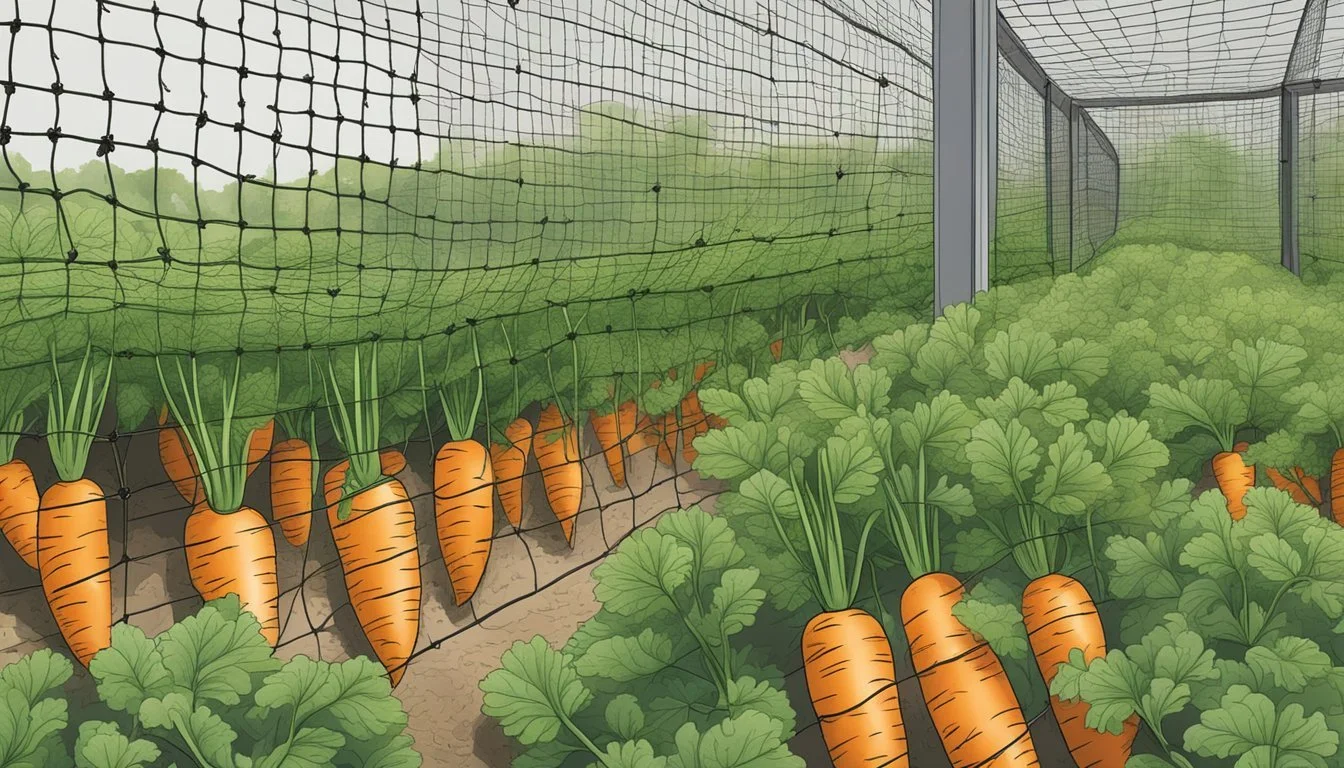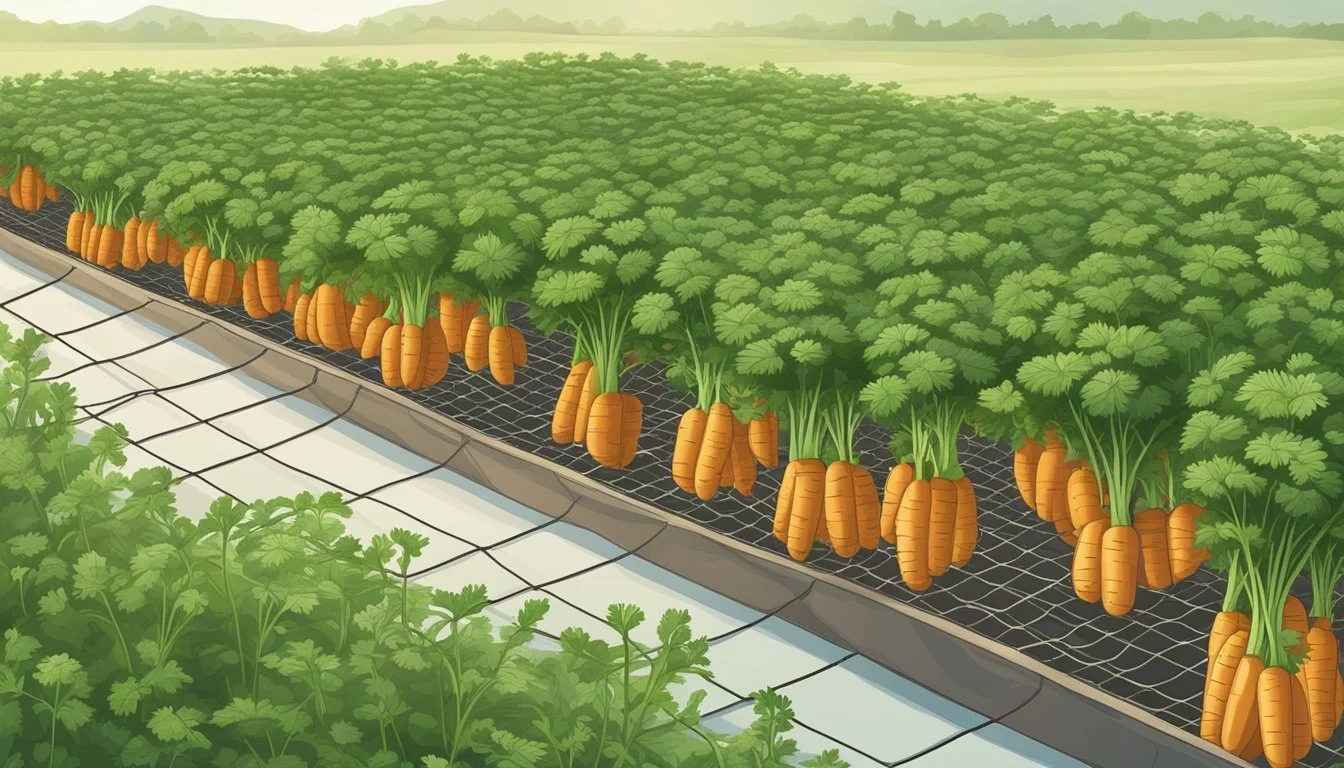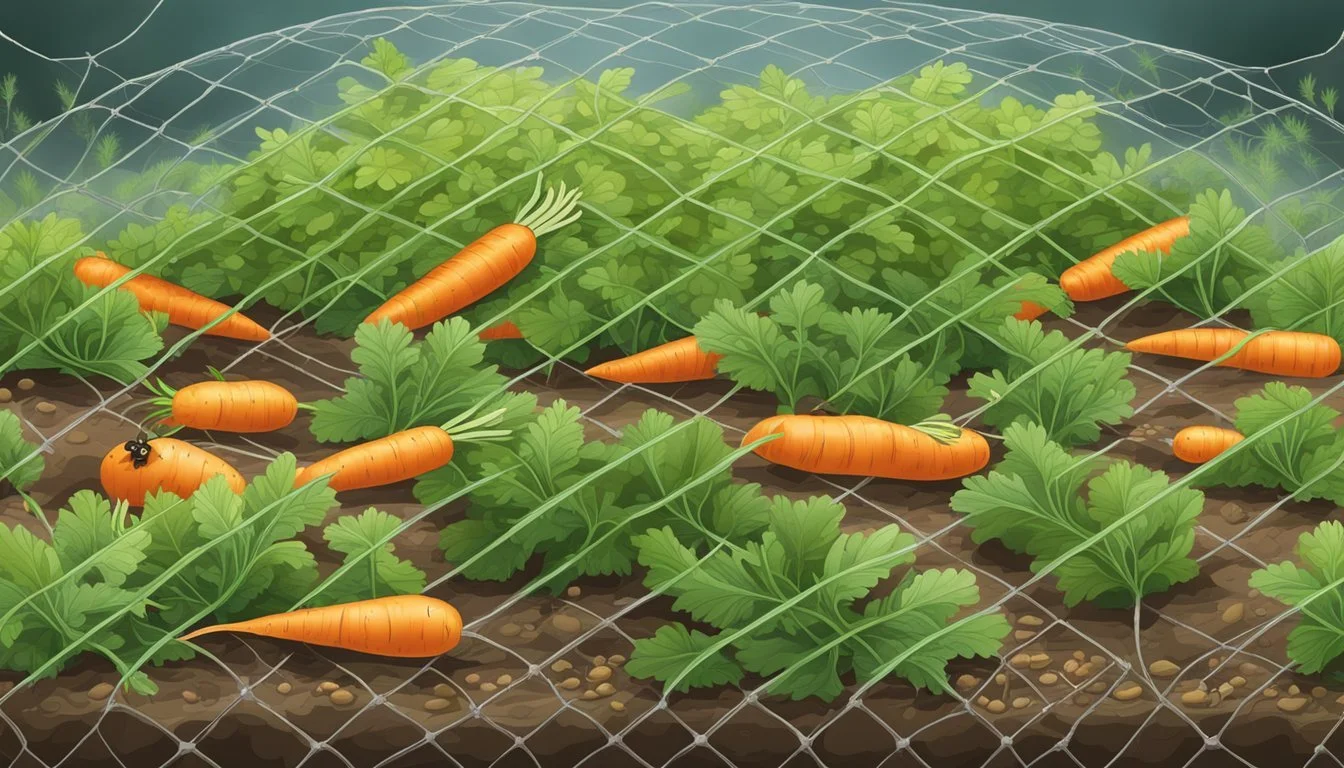Protecting Crops from Carrot Weevils
Effective Strategies for Pest Management
Carrot weevils, small yet destructive pests, pose a significant threat to commercial and personal carrot crops. These insects, particularly their larvae, are notorious for causing extensive damage, which can lead to substantial yield losses. Successful management of carrot weevils necessitates a thorough understanding of their lifecycle, since it is during the larval stage that they burrow into carrot roots, causing the most harm. Early identification is a key defense strategy, and growers must be adept at recognizing the signs of infestation, which include foliage with notches and roots with tell-tale larval tunnels.
Integrated pest management (IPM) strategies combine various control methods to protect carrot crops from carrot weevils. Cultural practices, such as crop rotation and the use of row covers, can be quite effective in preventing weevil infestation. Further, biological control agents and certain environmentally-friendly pesticides offer means for growers to combat existing carrot weevil populations without resorting to harsh chemicals. Understanding the behaviors of carrot weevils, such as their propensity to overwinter in soil and plant debris, is fundamental in developing effective IPM plans to safeguard crops.
Moreover, engagement with current research is crucial as it can highlight new and innovative control measures. Knowledge about the latest findings in carrot weevil management practices equips farmers with a robust set of tools to address these challenges, ensuring healthier crops and better harvests. Therefore, staying informed and adopting a combination of identification and control techniques represents the best line of defense against the pervasive carrot weevil.
Understanding Carrot Weevils
Carrot weevils, known scientifically as Listronotus oregonensis, are a significant pest of carrot crops. They have distinct life stages which can all cause damage to carrot roots, and they are found predominantly in North America.
Biology of Carrot Weevils
The carrot weevil undergoes a complete metamorphosis including egg, larvae, pupa, and adult stages forming its life cycle. Females lay tiny, white eggs near the crowns of carrot plants. The eggs hatch into larvae, which progress through several instars, becoming more destructive as they grow. They primarily feed inside the carrot root, creating telltale tunnels. The life cycle can spawn multiple generations annually, depending on the climate.
Identification and Description
Adult carrot weevils are small beetles approximating 6 mm in length, equipped with an identifying snout and elbowed antennae. They possess wings but are not known for being strong fliers. The weevils are typically brown or gray, with the larvae being cream-colored and legless, nestled within the carrot roots they infest.
Geographical Distribution
Carrot weevils are predominantly located in Canada and the eastern United States, making North America their primary habitat. The pest's distribution correlates closely with the availability of their preferred hosts, including cultivated carrots and related wild species. Their presence and activity can be site-specific and heavily influenced by local environmental conditions.
Crop Management Strategies
Effective management of carrot weevils involves a blend of cultural, physical, and biological approaches aimed at reducing the population and preventing damage to crops like carrot, parsnip, and parsley, which all belong to the Apiaceae family.
Cultural Controls
Cultural control strategies play a pivotal role in carrot weevil management. One key measure is crop rotation, as it hinders the life cycle of the weevil by removing their preferred host plants. It is recommended to rotate with non-Apiaceae crops to break the pest's life cycle. Moreover, the practice of eliminating weeds and maintaining healthy soil conditions can also reduce the habitat suitability for carrot weevils, thereby minimizing their impact.
Physical Barriers
Physical barriers, such as row covers or floating row covers, can be very effective at preventing carrot weevils from reaching the crops. Properly installed, these covers can act as a shield, especially if applied when the crops are planted until the carrot weevil flight activity diminishes. Boivin traps, which are specialized traps developed for carrot weevils, can also be used to monitor and reduce weevil populations.
Biological Controls
Biological control involves employing natural enemies of the carrot weevil. Beneficial nematodes like Steinernema carpocapsae and Heterorhabditis bacteriophora can be applied to the soil to target the larval stages of the weevil. Another biological approach is the introduction of predators and parasitoid wasps, such as ground beetles and parasitic wasps, which can feed on and help to control the weevil population. The bacterium Bacillus thuringiensis has been implemented against larvae, while beneficial insects can contribute toward the long-term suppression of carrot weevils.
Chemical Control Options
Effective management of carrot weevils often requires the implementation of chemical control measures. The selection of insecticides must balance efficacy with environmental impact to ensure crop health and compliance with agricultural standards.
Insecticide Application
Chemicals such as diazinon and malathion have been traditionally used for the control of carrot weevils. Applications of these insecticides need to be carefully timed to target the adult weevil before egg-laying begins. More recently, pyrethroids have gained attention as an effective option, known for their rapid action against a broad range of pests.
Malathion: Commonly applied as a foliar spray.
Diazinon: Previously registered for carrot weevil control but may be restricted in certain areas.
Methomyl: Effective, yet its use is limited by strict safety regulations.
Pyrethroids: Synthetic insecticides that mimic the natural pyrethrin found in chrysanthemum flowers.
Organic Pesticides
Organic pesticides provide alternatives for those seeking less harsh chemical treatments. Ingredients such as neem and beauveria bassiana, a naturally occurring fungus, play a role in this sector. Neem-based sprays can be effective in repelling carrot weevils, with the added benefit of having minimal impact on non-target organisms. Soapy water solutions also serve as a mild insecticidal option, though their effectiveness compared to stronger chemical pesticides might be lower. Milky spore is another organic choice, known primarily for grub control, but its impact on carrot weevil populations requires further exploration.
Neem-Based Sprays: Act as antifeedants and growth regulators for various insects.
Beauveria Bassiana: Utilizes fungal spores that infect and kill the weevils.
Soapy Water: Can be directly applied to plants to kill weevils on contact.
Milky Spore: Potato-based granules applied to soil to combat larvae.
Monitoring and Detection
Effective management of carrot weevils begins with diligent monitoring and detection practices. It is crucial to accurately identify the presence of weevils, both adults and larvae, and assess the level of infestation to apply control measures timely and effectively.
Scouting and Inspection
Regular scouting and inspection of carrot crops is essential for early detection of carrot weevils. One should inspect the foliage for signs of feeding and look closely at the roots for evidence of larval activity. Adults typically feed on foliage, which creates notches on the leaf margins. Identification of larvae requires more thorough inspection, as they burrow into the roots, causing significant damage. Carrot weevil larvae are cream-colored, legless, and have a distinctively curved posture.
Traps and Lures
To monitor carrot weevil adults, one can use traps baited with an alluring scent. Traps can be simple mason jars or paper cups buried at ground level with the rims flush with the soil surface. Bait, often fermenting fruit or a commercially available pheromone, is placed inside to lure weevils. This technique not only helps to detect the presence of adult carrot weevils but can also aid in gauging the population level within the crop. Regular checks of these traps provide insight into whether the pest numbers are increasing or decreasing, informing the need for further action.
Impact on Crops and Management
Carrot weevils pose a significant threat to apiaceous crops such as carrots (how long do carrots last?), celery (how long does celery last?), and parsnips, particularly through larval tunneling that can render the produce inedible. Effective management strategies are crucial in mitigating the extensive damage they cause.
Damage Assessment
Carrot weevils overwinter in the soil and emerge in spring to feed and mate. Female weevils lay eggs near the crowns of host plants, and upon hatching, the larvae bore into the roots, creating extensive tunnel networks. These tunnels, coupled with feeding scars, can lead to secondary infections and compromised plant integrity, often causing wilting or eventual plant death. In commercial production, carrots affected by weevils are considered inedible and unmarketable, reflecting the true impact of infestation. Early damage assessment is imperative, as visually evident wilting may signify severe larval infiltration.
Impact of Infestations
The presence of carrot weevils in a crop can lead to yield losses ranging from moderate to complete, depending on infestation levels. Infested plants typically exhibit wilting, and when uprooted, show clear signs of larval entry. This damage extends beyond the visible scars: infested roots are prone to rot, making the crops unsuitable for consumption. Apiaceous crops, including parsley and celery, are also at risk, highlighting the weevil's lack of discrimination within this plant family. In the worst cases, entire fields can be rendered unharvestable, striking a heavy blow to the agricultural sector reliant on these crops.
Management of carrot weevils involves integrated pest management (IPM) strategies, including crop rotation, biological controls such as natural predators or parasitoids, chemical treatments targeted at the adult weevils to prevent egg laying, and monitoring programs that enable timely interventions. Understanding the weevil’s life cycle is fundamental in crafting a management plan that effectively protects valuable Apiaceae crops from irreparable harm.
Preventive Measures
Effective management of carrot weevils begins with proactive strategies aimed at minimizing the opportunity for infestation and disrupting the weevil’s lifecycle. Here are targeted actions one can take to prevent these pests from damaging carrot crops.
Soil Management
To combat carrot weevils, it is crucial to disrupt their lifecycle, which is primarily soil-based. Management of the top layer of soil where weevils overwinter can significantly reduce their populations. It is recommended to till the soil to destroy pupae before planting. This physically disrupts the environment carrot weevils need to overwinter and can lead to a reduction in the adult population come spring.
Crop Rotation and Companion Planting
Crop rotation is a potent tool in pest management. By planting carrot crops in different locations each year, one can limit the continual buildup of carrot weevil populations in the soil. Furthermore, integrating companion planting with strong-scented plants like onions and parsley can act as a repellent, thereby offering an additional layer of protection for carrots. This tactic not only deters carrot weevils but can also support overall garden health.
Lifecycle and Reproduction
Understanding the lifecycle and reproduction of carrot weevils is essential for effective pest management. Specific stages from egg to adult influence control strategies.
Stages of Development
The life cycle of carrot weevils comprises four distinct stages: egg, larva, pupa, and adult. Females lay their eggs on the foliage near the crown of the carrot plant in spring. Upon hatching, the larvae burrow into the carrot, passing through several instars, or growth phases, as they develop. This larval stage can cause significant crop damage. The pupa stage occurs within the soil, offering a crucial period for pest control before the emergence of adults. Carrot weevils typically have one or two generations per year, depending on the climate.
Reproductive Behaviors
The mating behaviors of carrot weevils are timed with plant growth cycles. Females exhibit a reproductive pattern that involves mating and then egg-laying shortly after adult weevils have emerged in the spring. The number of eggs a female lays can directly influence the potential population size for the season and future generations. Effective control often hinges upon targeting the weevils during this reproductive phase to intercept the cycle before larvae infestation becomes severe.
Natural History and Behavior
Carrot weevils are a significant agricultural pest with a life cycle intricately tied to their host plants within the Apiaceae family. Understanding their seasonal patterns and feeding behavior is crucial for effective pest management strategies.
Seasonal Habits
Carrot weevils (Listronotus oregonensis) emerge in spring as temperatures rise. They overwinter in the soil as adults, near fields where carrots or related crops were previously planted. Their appearance coincides with the germination of many host plants, initiating their reproductive and feeding cycle.
Feeding and Host Plants
The adult carrot weevil possesses a distinctive snout used to feed on foliage. However, the larvae are the primary concern as they burrow into the roots of carrots and other carrot family members, causing considerable damage. Preferred host plants include various cultivated crops, like parsley, and celery, beyond just carrots.
Integrated Pest Management
Integrated Pest Management (IPM) is a comprehensive approach to controlling pests like the carrot weevil. It combines cultural, biological, and chemical methods to optimize crop protection while minimizing environmental impact.
IPM Strategies
Cultural Controls: This involves practices that reduce the carrot weevil's ability to establish and thrive. Crop rotation and sanitation can significantly decrease the weevil population by removing plant debris that may harbor larvae or adults.
Biological Controls: Beneficial insects and natural predators can be introduced or encouraged to keep the carrot weevil population in check. For instance, the introduction of parasitoid wasps targets the weevil's larvae stage.
Chemical Control: When necessary, judicious use of insecticides can provide immediate relief from severe infestations. However, it should be applied as a last resort and in a way that limits harm to non-target species.
Record Keeping and Decision Making
Inspect and Identification: Regular monitoring and accurate identification of the carrot weevil presence are crucial. Using traps can aid in timely detection.
Decision Making: Keeping detailed records of infestation levels, weather patterns, and crop stages can inform better decision-making. This ensures that interventions are timely and appropriate to the life cycle of the weevil and agronomic calendar.
Frequently Asked Questions
When dealing with carrot weevils, detailed knowledge of prevention and control tactics is essential for protecting your crops effectively.
What methods can be employed to prevent carrot weevil infestation?
Preventing carrot weevil infestations involves cultural practices such as crop rotation and maintaining garden cleanliness to remove potential breeding grounds. Using row covers can also hinder adult weevils from laying eggs on the carrot plants.
Are there any effective natural remedies to protect crops against carrot weevils?
There are natural remedies for combatting carrot weevils, such as introducing beneficial organisms like Milky spore and Bacillus thuringiensis, which target and kill the grubs. Another method is the use of baited traps with soapy water to drown the larvae.
What are the signs of carrot weevil damage on crops?
Carrot weevils leave distinct signs of damage, such as dark feeding tunnels, often gaping open in the upper third of the carrot root. Additionally, affected plants may display wilting, yellowing, or stunted growth.
At what stage of development are carrot weevils most harmful to crops?
Carrot weevils are most harmful during their larval stage, as they burrow into the carrot roots, causing significant damage. The adult weevils lay eggs in the crown of the plant, which develop into larvae that feed on the roots.
Can crop rotation be used as a strategy to combat carrot weevil populations?
Yes, employing crop rotation is an effective strategy. Moving carrots to different planting areas each season can disrupt the life cycle of the carrot weevil and reduce their populations over time.
What are the best practices for removing carrot weevils from affected fields?
The best practices for removing carrot weevils include removing and destroying infested carrots and crop debris. Practices such as tilling the soil can expose the weevil larvae, making them vulnerable to predators and weather conditions.





